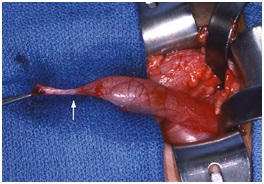Robot in Ureterovesical Junction Stenosis; Robotic Ureteral Reimplantation, Robotic Ureteroneocystostomy
What is ureterovesical junction obstruction?
The ureterovesical junction is the junction of the bladder and the tube-shaped ureters that carry urine from the kidney to the bladder. Ureterovesical junction obstruction describes the obstruction in this region. In the case of obstruction/ stenosis, the urine cannot easily empty into the bladder; As urine accumulates in the ureter, it causes enlargement of the ureter (megaureter) and enlargement of the kidney (hydronephrosis).
How Is ureterovesical junction obstructiontreated?
These patients need close monitoring. If the obstruction impairs kidney function, surgical treatment is necessary. In ureterovesical junction obstruction, surgical treatment is performed to preserve kidney function.
What is open ureteral reimplantation (ureteroneocystostomy)?

Figure 1: The view of the ureter after liberation and cutting in a patient with left ureterovesical stenosis. The white arrow points to the narrow segment at the lower end of the ureter.
Are there other surgical treatment options?
Other treatment options are ureteral reimplantation with closed methods (laparoscopic or robotic). In these approaches, the body is entered with a camera and other instruments placed through 3-4 small holes to be opened in the abdominal wall instead of a skin incision (figure 2). I successfully apply both treatment options to my patients.
 Figure 2: The placement of the trocars and the position of the patient in a case where I performed robotic ureteroneocystostomy.
Figure 2: The placement of the trocars and the position of the patient in a case where I performed robotic ureteroneocystostomy.
What are the advantages of robotic ureteral reimplantation?
Advantages: small skin incision, larger and clearer image under optical magnification, less postoperative pain, shorter postoperative hospital stay (1-2 days), faster recovery and return to normal life.
Is the doctor important in robotic ureterovesical junction stenosis surgery?
As in all urological surgeries, it is very important that the surgeon performing the surgery is experienced. After all, the one who controls the robot is a surgeon. For a successful and smoother operation, it is necessary to have an operation with a doctor who is specialized in robotic surgery.


